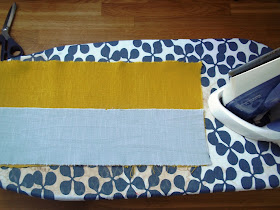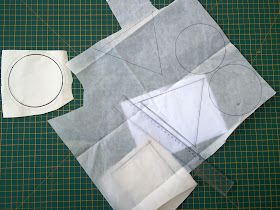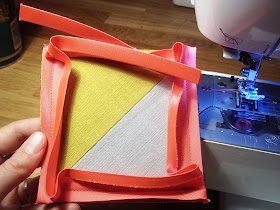I made coasters.
I happened to have a lot of neon pink bias tape, and my desk needed brightening up. Coasters to the rescue! Grey, mustard and neon pink is a pretty unbeatable combination, isn't it?
I'm willing to bet that you've got a surface of some kind, somewhere, that wants some geometric fun adding. Right? Yes! You know you want to...
Supplies
You'll need:
- woven fabric in two colours, for the top of your coasters. Large scraps will be fine.
- Pleather (or real leather, if you want to be fancy :-) for the backing. A fat quarter-sized piece will be plenty. In fact a fat eighth - is that a thing? - would probably be enough.
- double-sided fusible interfacing: a small-ish piece, about as much as your pleather.
- bias tape: 50 cm / a half yard will do it.
- a square thing and a round thing to draw around - see tips below - or a compass and set square/protractor.
- a ruler.
- a pencil or pen.
All set!
So, get your round thing and square thing, and draw around them to make your coaster templates. No seam allowance needed: the shape you draw will be the finished size of your coasters
As you can see, I used an oversized mug and a coaster.
My finished templates were an 11 cm square and a 12 cm diameter circle.
At this point in the photos you need to start ignoring the fact that I considered experimenting with triangular coasters too. Short version: they don't work, unless you know a magic way of attaching bias tape around that kind of angle (please share!), and don't mind having to make a very big pointy triangle to get a surface big enough to sit your mug on.
Lay out your templates on one of your woven fabric pieces and cut/rip it to a size they'll all fit on. You need to leave a scant seam allowance at the long sides.
Use your first cut-to-size piece to cut an equally-sized piece of your other woven fabric.
So you have this:
Now cut/rip one of the pieces in half:
And we're going to sew them together like this:
I found this was a good point to iron my pieces, especially as I'd ripped rather than cut them. A quick press got them in good shape to be sewn!
With right sides together, place the side fabric pieces on top of the main piece, aligning the edges:
Pin:
And then sew them together with a quarter-inch or 5 mm seam allowance:
Press the seams open from the wrong side...
... and then press them nice and flat on the right side:
And that's your fabric prepped! Do take care to sew in a straight line and press the seams out nicely - the fabric joins are the feature that pops out in the middle of your coaster, so you don't want them to be wonky!
Draw a line across the centre of your shapes. For the circles I folded the shape in half and pinched the edges - drawing between these pinches gave me a nice line right across the centre of the circle. For the squares I drew diagonally between opposite corners.
Now iron your fusible interfacing to the WRONG side of your prepped fabric piece, i.e. seams facing up, with the lines on your shapes aligned exactly along the seams.
Cut your shapes out...
... and peel off the paper backing:
Now iron your shapes to your (p)leather, wrong sides together. As you can see, the back of my pleather is black:
Use a fairly low heat on your iron so the pleather doesn't melt or get burnt.
Cut the shapes out:
Your coasters are taking shape!
So, take your bias, which if you're using shop-bought will look like this (if yours is homemade, iron it accordingly :-).
Iron it in half along the length of the tape, but not exactly in half: one side should be slightly wider than the other. I'm afraid I forgot to photograph that bit...
Before we start: I'm going to show you how to do the square coasters, as you'll need to mitre the corners. The principle is the same for the round shapes, but you have no corners to deal with. I am no great expert on mitring, and I suspect those who quilt will have much more experience and better results on this. I learned how to do it with this BurdaStyle tutorial. There are photo and video tutorials available if you google it, which you may well find clearer than mine!
So to begin, open out the folds in the tape along the narrower side, and align it with the edge of one of your coasters. Leave a good 'tail' of bias tape (3 inches or so) before the point where you're going to start sewing.
Starting about three quarters of the way down one side, sew the tape to the coaster, exactly in the fold nearest the edge:
Stop just before the corner. The distance to leave should be the same as the distance between the line you just sewed, and the edge of the coaster.
Then fold the bias tape across by 90 degrees, so that the folded-out edge is aligned with the next side of the coaster. The tip of the fold in the tape should meet the corner of the coaster. I hope this picture is clear enough...
Starting a small distance along from the corner, at exactly the same level that you stopped sewing the previous edge, sew the bias tape along the next side of the coaster, exactly in the fold as before.
Again, stop before you get to the corner. So the second side of your coaster should now look like this:
Repeat for all sides. When you've done the last corner, sew about a quarter of the way down the side and then stop. Cut the bias tape, leaving a length free after the stitching. You will now have this:
Align the tails of the bias tape along the edge of the coaster, pinch together and mark where they join:
Sew the end of the bias tape together, with the marks matching up. You'll need to wrestle your coaster around a bit here - just take your time and don't panic! Trim the seam:
So you now have this:
And then sew the remaining bit of tape down to the coaster, along the fold:
Here's what you get:
And then you flip the bias tape over to enclose the raw edges, at which point the corners mitre themselves! Well OK, you may need to manipulate them into place a bit :-)
Also, as my pleather was quite thick, I trimmed the edges by about 2 mm as otherwise my bias tape simply wouldn't fit around it. If your (p)leather is thinner you may find you don't need to do this.
Make sure that your bias tape is folded nicely down neatly, pulled taut over the edges, and reaches to cover the sitiching which you'll currently have visible on the back of your coaster.
Once you've done this, stitch the tape down from the front side of your coaster, very close to the folded edge (if you're any good at stitching in the ditch, you can do that. I'm not :-).
Sew all the way round and - ta da!! Finished square coaster!
Here's the mitred corner from the front:
And from the back:
But just to reassure anyone who might be cursing me and my fiddly bias tape thing right now - I also did some that look like this:
It's the back, no-one will know :-)
But - this is the reason that I decided not to give these coasters away on Giveaway Day. More than good enough for personal use - I love them, in fact - but my perfectionist tendencies wouldn't let me offer such shoddy handiwork to anyone else. But really, that's just me - who said homemade homewares really had to be perfect?
Anyway, repeat this on all your coasters, and then sit back and congratulate yourself! With some coffee.
Or tea. Or other beverage of your choice. What lovely mugfuls would your coasters hold?
Whatever it is, I hope the tutorial's clear enough, and that you like it!











































I love the bright pink with the mustard. Your tutorial is great.. and isn't that frustrating when you sew off the binding. Too many times I've done it.
ReplyDelete